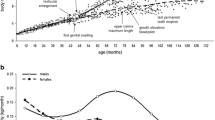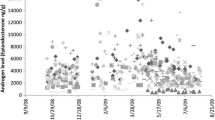Abstract
Over a 30-year period from 1954 to 1983, 975 live births were recorded for Japanese macaque females at the Iwatayama Monkey Park, Arashiyama, Japan. Excluding unknown birth dates, primiparous mothers gave birth to 185 infants (182 cases with age of mother known) and multiparous mothers gave birth to 723 infants (603 cases with age of mother known). The peak month of birth was May with 52.3% of the total births occurring during the period. Multiparous females who had not given birth the previous year did so earlier than multiparous females who had given birth the previous year and also earlier than primiparous females. Among the females who had given birth the previous year, females whose infant had died gave birth earlier than females who had reared an infant the previous year. The offspring sex ratio (1:0.97) was not significantly different from 1:1, and revealed no consistent association with mother's age. Age-fecundity exhibited a humped curve. The annual birth rate was low at the age of 4 years but increased thereafter, ranging between 46.7% and 69.0%, at between 5 and 19 years of age, but again decreased for females between 20 and 25 years of age. Some old females displayed clear reproductive senescence. The infant mortality within the first year of age was quite low (10.3%) and the neonatal (less than 1 month old) mortality rate accounted for 49.0% of all infant deaths. There was no significant difference between the mortality rates of male and female infants. A female's rank-class had no apparent effect on the annual birth rate, infant mortality, and offspring sex ratio. These long-term data are compared with those from other primate populations.
Similar content being viewed by others
References
Abbott, D. H., 1987. Behaviourally mediated suppression of reproduction in female primates.J. Zool., Lond., 213: 455–470.
Altmann, J., 1980.Baboon Mothers and Infants. Harvard Univ. Press, Cambridge, Massachusetts.
————,G. Hausfater, &S. A. Altmann, 1988. Determinants of reproductive success in savannah baboons,Papio cynocephalus. In:Reproductive Success,T. H. Clutton-Brock (ed.), Univ. of Chicago Press, Chicago, pp. 403–418.
Aureli, F., G. Schino, C. Cordischi, R. Cozzolino, S. Scucchi, &C. P. van Schaik, 1990. Social factors affect secondary sex ratio in captive Japanese macaques.Folia Primatol., 55: 176–180.
Berman, C. M., 1988. Maternal condition and offspring sex ratio in a group of free-ranging rhesus monkeys: An eleven-year study.Amer. Naturalist, 131: 307–328.
————, &R. G. Rawlins, 1985. Maternal dominance, sex ratio and fecundity in one social group on Cayo Santiago.Amer. J. Primatol., 8: 322.
Cheney, D. L., P. C. Lee, &R. M. Seyfarth, 1981. Behavioral correlates of non-random mortality among free-ranging female vervet monkeys.Behav. Ecol. Sociobiol., 9: 153–161.
————,R. M. Seyfarth, S. J. Andelman, &P. C. Lee, 1988. Reproductive success in vervet monkeys. In:Reproductive Success,T. H. Clutton-Brock (ed.), Univ. of Chicago Press, Chicago, pp. 384–402.
Clark, T. W. &T. Mano, 1975. Transplantation and adaptation of a troop of Japanese monkeys to a Texas brushland habitat. In:Contemporary Primatology, 5th International Congress of Primatology,S. Kondo,M. Kawai, &A. Ehara (eds.), Karger, Basel, pp. 358–361.
Dittus, W. P. J., 1979. The evolution of behaviors regulating density and age-specific sex ratios in a primate population.Behaviour, 69: 265–302.
Drickamer, L. C., 1974. A ten-year summary of reproductive data for free-rangingMacaca mulatta.Folia Primatol., 21: 61–80.
Dunbar, R. I. M., 1980. Determinants and evolutionary consequences of dominance among female gelada baboons.Behav. Ecol. Sociobiol., 7: 253–265.
————, 1987. Demography and reproduction. In:Primate Societies,B. B. Smuts,D. L. Cheney,R. M. Seyfarth,R. W. Wrangham, &T. T. Struhsaker (eds.), Univ. of Chicago Press, Chicago, pp. 240–249.
———— &E. P. Dunbar, 1977. Dominance and reproductive success among female gelada baboons.Nature, 266: 351–352.
Fairbanks, L. A. &M. T. McGuire, 1984. Determinants of fecundity and reproductive success in captive vervet monkeys.Amer. J. Primatol., 7: 27–38.
Fedigan, L., 1991. Life span and reproduction in Japanese macaque females. In:The Monkeys of Arashiyama: Thirty-five Years of Research in Japan and the West,L. M. Fedigan &P. J. Asquith (eds.), SUNY Press, New York, pp. 140–154.
Fedigan, L. M., 1983. Dominance and reproductive success in primates.Yb. Phys. Anthropol., 26: 91–129.
————,L. Fedigan, S. Gouzoules, H. Gouzoules, &N. Koyama, 1986. Lifetime reproductive success in female Japanese macaques.Folia Primatol., 47: 143–157.
Gouzoules, H., S. Gouzoules, &L. M. Fedigan, 1982. Behavioural dominance and reproductive success in female Japanese monkeys (Macaca fuscata).Anim. Behav., 30: 1138–1150.
Harcourt, A. H., 1987. Dominance and fertility among female primates.J. Zool., Lond., 213: 471–487.
Harvey, N. C. &R. J. Rhine, 1983. Some reproductive parameters of stumptailed macaques (Macaca arctoides).Primates, 24: 530–536.
Huffman, M. A., 1991. History of Arashiyama Japanese macaques in Kyoto, Japan. In:The Monkeys of Arashiyama: Thirty-five Years of Research in Japan and the West,L. M. Fedigan &P. J. Asquith (eds.), SUNY Press, New York, pp. 21–53.
Koyama, N., 1967. On dominance rank and kinship of a wild Japanese monkey troop in Arashiyama.Primates, 8: 189–216.
————, 1970. Changes in dominance rank and division of a wild Japanese monkey troop in Arashiyama.Primates, 11: 335–390.
————,K. Norikoshi, &T. Mano, 1975. Population dynamics of Japanese monkeys at Arashiyama. In:Contemporary Primatology,S. Kondo,M. Kawai, &A. Ehara (eds.), Karger, Basel, pp. 411–417.
Mace, G. M., 1990. Birth sex ratio and infant mortality rates in captive western lowland gorillas.Folia Primatol., 55: 156–165.
Maruhashi, T., 1982. An ecological study of troop fissions of Japanese monkeys (Macaca fuscata yakui) on Yakushima Island, Japan.Primates, 23: 317–337.
Meikle, D. B., B. L. Tilford, &S. H. Vessey, 1984. Dominance rank, secondary sex ratio, and reproduction of offspring in polygynous primates.Amer. Naturalist, 124: 173–188.
———— &S. H. Vessey, 1988. Maternal dominance rank and lifetime survivorship of male and female rhesus monkeys.Behav. Ecol. Sociobiol., 22: 379–383.
Nakamichi, M., 1984. Behavioral characteristics of old female Japanese monkeys in a free-ranging group.Primates, 25: 192–203.
Nieuwenhuijsen, K., Ad J. J. C. Lammers, K. J. de Neef, &A. K. Slob, 1985. Reproduction and social rank in female stumptail macaques (Macaca arctoides).Int. J. Primatol., 6: 77–99.
van Noordwijik, M. A. &C. P. van Schaik, 1987. Competition among female long-tailed macaques,Macaca fascicularis. Anim. Behav., 35: 577–589.
Paul, A. &J. Kuester, 1990. Adaptive significance of sex ratio adjustment in semifree-ranging Barbary macaques (Macaca sylvanus) at Salem.Behav. Ecol. Sociobiol., 27: 287–293.
———— &D. Thommen, 1984. Timing of birth, female reproductive success and infant sex ratio in semifree-ranging Barbary macaques (Macaca sylvanus).Folia Primatol., 42: 2–16.
Pavelka, M. S. M. &L. M. Fedigan, 1991. Menopause: A comparative life history perspective.Ybk. Phys. Anthropol., 34: 13–38.
Rawlins, R. G. &M. J. Kessler, 1986. Secondary sex ratio variation in the Cayo Santiago macaque population.Amer. J. Primatol., 10: 9–23.
van Schaik, C. P., W. J. Netto, A. J. J. van Amerongen, &H. Westland, 1989. Social rank and sex ratio of captive long-tailed macaque females (Macaca fascicularis).Amer. J. Primatol., 19: 147–161.
Silk, J. B., 1983. Local resource competition and facultative adjustment of sex ratios in relation to competitive abilities.Amer. Naturalist, 121: 56–66.
————, 1988. Maternal investment in captive bonnet macaques (Macaca radiata).Amer. Naturalist, 132: 1–19.
————,C. B. Clark-Wheatley, P. S. Rodman, &A. Samuels, 1981. Differential reproductive success and facultative adjustment of sex ratios among captive female bonnet macaques (Macaca radiata).Anim. Behav., 29: 1106–1120.
Simpson, M. J. A. &A. E. Simpson, 1982. Birth sex ratios and social rank in rhesus monkey mothers.Nature, 300: 440–441.
Small, M. F. &S. B. Hrdy, 1986. Secondary sex ratios by maternal rank, parity, and age in captive rhesus macaques (Macaca mulatta).Amer. J. Primatol., 11: 359–365.
Smuts, B. B. &N. Nicolson, 1989. Reproduction in wild female olive baboons.Amer. J. Primatol., 19: 229–246.
Sugiyama, Y. &H. Ohsawa, 1982. Population dynamics of Japanese monkeys with special reference to the effect of artificial feeding.Folia Primatol., 39: 238–263.
Suzuki, A., K. Wada, S. Yoshihiro, E. Tokita, S. Hara, &Y. Aburada, 1975. Population dynamics and group movement of Japanese monkeys in Yokoyugawa Valley, Shiga Heights.Phys. Ecol., 16: 15–23. (in Japanese)
Takahata, Y., 1980. The reproductive biology of a free-ranging troop of Japanese monkeys.Primates, 21: 303–329.
————, 1982. The socio-sexual behavior of Japanese monkeys.Z. Tierpsychol., 59: 89–108.
————, 1991. Diachronic changes in the dominance relations of adult female Japanese monkeys of the Arashiyama B group. In:The Monkeys of Arashiyama: Thirty-five Years of Research in Japan and the West,L. M. Fedigan &P. J. Asquith (eds.), SUNY Press, New York, pp. 123–139.
Trivers, R. L. &D. E. Willard, 1973. Natural selection of parental ability to vary the sex ratio of offspring.Science, 179: 90–92.
Whitten, P. L., 1983. Diet and dominance among female vervet monkeys (Cercopithecus aethiops).Amer. J. Primatol., 5: 139–159.
————, 1984. Competition among female vervet monkeys. In:Female Primates: Studies by Women Primatologists,M. F. Small (ed.), Alan R. Liss, Inc., New York, pp. 127–140.
Wolfe, L. D., 1984. Female rank and reproductive success among Arashiyama B Japanese macaques (Macaca fuscata).Int. J. Primatol., 5: 133–143.
Author information
Authors and Affiliations
About this article
Cite this article
Koyama, N., Takahata, Y., Huffman, M.A. et al. Reproductive parameters of female Japanese macaques: Thirty years data from the arashiyama troops, Japan. Primates 33, 33–47 (1992). https://doi.org/10.1007/BF02382761
Received:
Accepted:
Issue Date:
DOI: https://doi.org/10.1007/BF02382761




